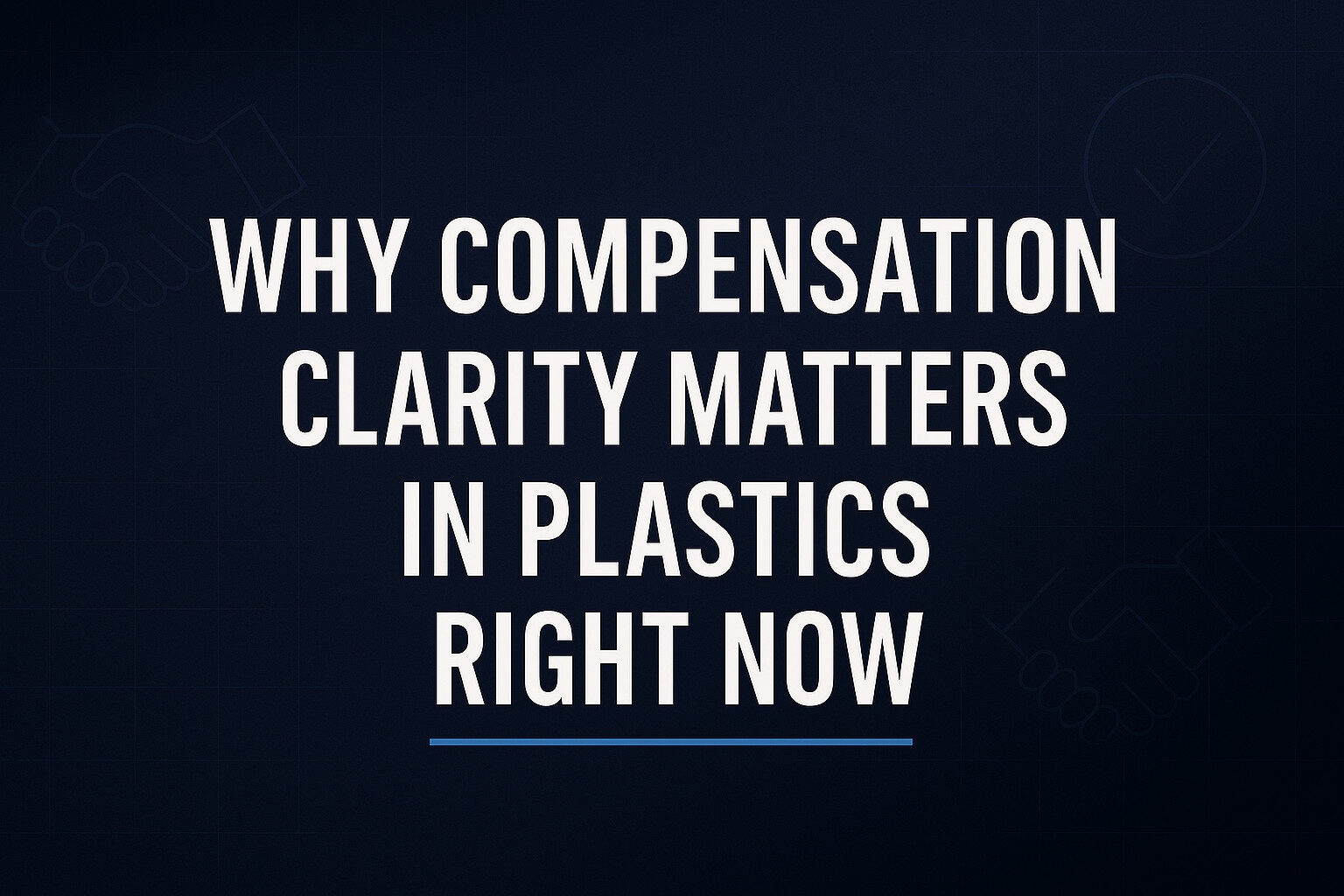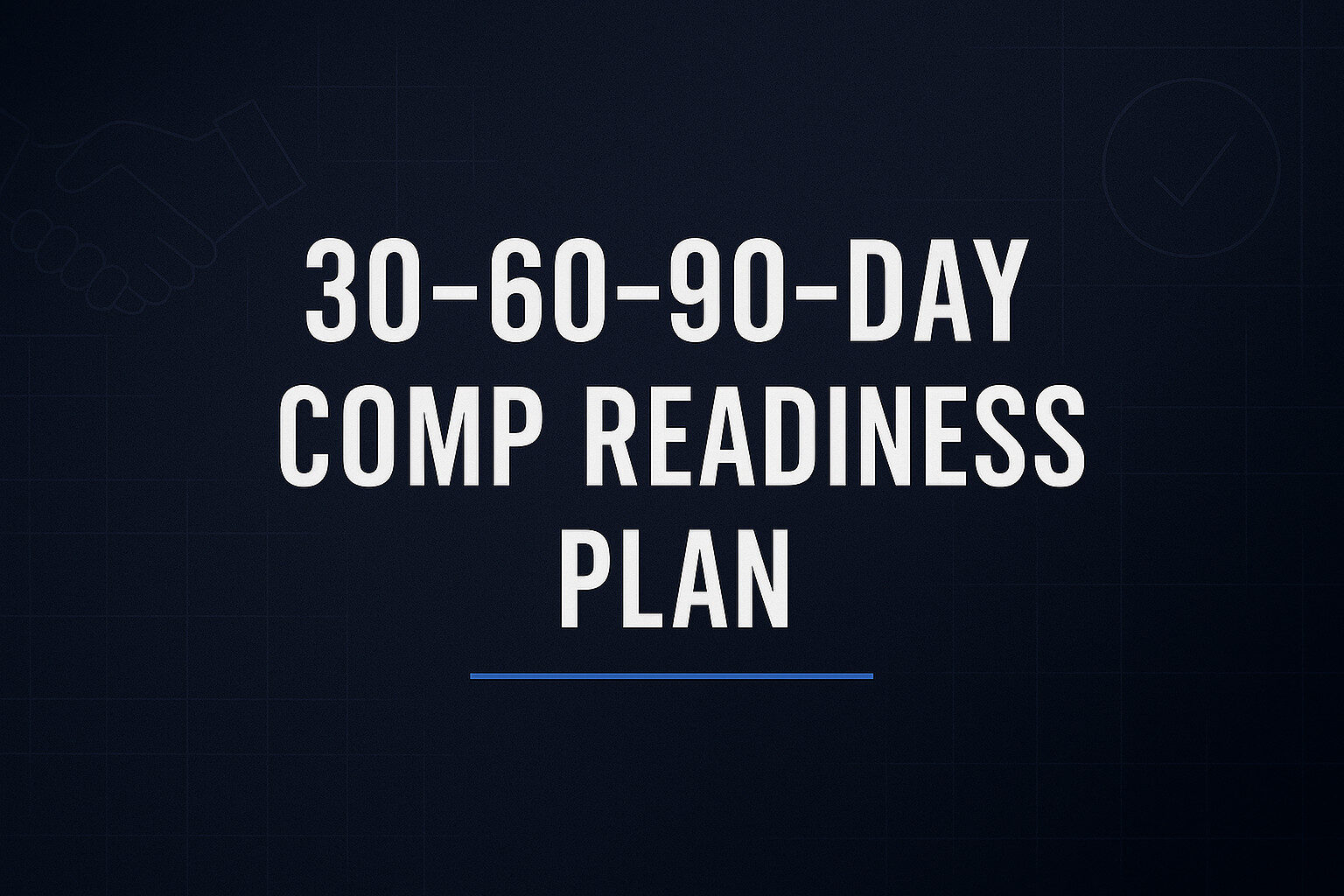If you’re leading an executive search in plastics, you’ve got a narrow window to court scarce operators, commercial leaders, and technical executives—while staying within a board-approved budget. The market hasn’t cooled evenly: unemployment in plastics and rubber remains bumpy, wages are still rising in many job families, and private companies are leaning harder on incentive pay and long-term awards. Your edge comes from knowing the current compensation landscape, publishing a credible pay philosophy, and negotiating fast, clean offers that speak to what elite candidates value now.
This guide distills what decision makers in the U.S. plastics sector need: current data signals, role-by-role pay architecture, and practical negotiation tactics that win candidates without bidding against yourselves.

Why compensation clarity matters in plastics right now
- The industry is large and active. The U.S. plastics sector supports about 1 million jobs and generated roughly $519B in shipments in 2023, with a larger footprint when suppliers are included.
- Wage pressure hasn’t vanished. Recent industry wage reports show continued year-over-year increases across processors—solidly above headline inflation in some cohorts.
- Executives expect variable pay and LTI. Among private companies, 82% now offer some form of long-term incentive (LTI), and annual incentive plans dominate at senior levels—patterns you’ll see across middle-market plastics, especially PE-backed firms.
Translation: to close top talent, you’ll need clear base-plus-incentive logic, evidence that targets are attainable, and a crisp story about how the role moves plant metrics (OEE, FPY, scrap), customer outcomes (OTIF, PPM), and P&L (EBITDA, working capital).
A quick look at current pay anchors (industry specific)
BLS industry-specific data for NAICS 326100 (Plastics Product Manufacturing) is a good, neutral reference when you need credible yardsticks for executive families. Below are selected national figures (all industries vary by metro and company size; use these as anchors, not absolutes):
Role family (NAICS 326100) | Annual mean |
Chief Executives | ~$278.6k |
General & Operations Managers | ~$156.9k |
Sales Managers | ~$158.4k |
Industrial Production Managers | ~$116.4k |
Source: U.S. Bureau of Labor Statistics, May 2023 OEWS, NAICS 326100. (Bureau of Labor Statistics)
Tip: Pair BLS anchors with current regional and company-size cuts from your own searches and internal HRIS. They’re excellent for board packs and comp committee discussions because the methodology is transparent.
What’s actually moving compensation in plastics (2024–2025 signals)
- Steady wage growth at processors. Trade benchmarking points to mid-single-digit wage increases year over year for plastics roles; many shops report 4–5% raises to compete, even as hiring plans modestly cool. (Plastics Business)
- More pay at risk. Private companies expanded annual incentive usage and LTI eligibility—especially for VP-level and above—to align leaders with profitability and cash. (Deloitte)
- Forecast volatility and bonus plans. Some middle-market manufacturers are tuning FY-2025 bonus mechanics because tariffs, input costs, and demand variability make original targets stale—important context for candidate conversations about “stretch vs. sandbag.” (Nelson Mullins Riley & Scarborough LLP)
Role-by-role pay architecture (how to design packages that close)
The art is balancing market-competitive with performance-credible. Below are practical structures U.S. plastics companies use to land leaders. Replace numbers with your ranges; keep the logic.
CEO/President (mid-market; private or PE-backed)
- Base: competitive for metro and scale; tie to revenue/EBITDA bands.
- Annual bonus: 40–80% target; metrics balanced across EBITDA, free cash flow, and strategic milestones (e.g., plant consolidation, acquisitions).
- LTI: 3–4-year RSUs or phantom equity with EBITDA and exit-value alignment (PE).
- Sweeteners: change-in-control protections, relocation with spousal career support, board education budget.
COO / EVP or VP Operations
- Base: set by multi-site scope and capex authority.
- Bonus: 30–60% target; weight to OEE, FPY, scrap, safety, on-time delivery, and working capital days.
- LTI: RSUs/phantom; tie vesting to reliability/throughput milestones and EBITDA.
- Clauses: KPI visibility (weekly dashboards); decision rights on maintenance staffing and utilities spend.
VP/Head of Quality & Regulatory
- Base: premium for IATF, medical, or high-compliance lines of business.
- Bonus: 25–45% target; weight to PPM, complaint cycle time, audit scores, CAPA closure, and customer scorecard wins.
- LTI: smaller than COO/CCO, but meaningful to retain independence.
- Clauses: independence language; authority over change control.
CCO / VP Sales
- Base + levered variable: 40–60% variable is common at VP Sales. Tie to profitable bookings, price/mix, renewal/retention, and distributor health, not just volume.
- LTI: vesting tied to growth quality (mix, margin) and strategic logos.
- Clauses: price-exception governance; channel conflict rules.
CFO (manufacturing-heavy)
- Base: aligned to balance sheet complexity and M&A.
- Bonus: 30–60%; metrics: cash conversion, inventory turns, days to close, forecast accuracy, audit results.
- LTI: step with leverage/time horizon (PE vs. family-owned).
Regional pay factors (how to talk about geography)
- Manufacturing hubs (Midwest, Southeast) often deliver better value per comp dollar and lower relocation friction.
- Coastal metros (Northeast, West Coast) command higher base but don’t always add plastics-specific bench strength.
- Site proximity still matters for the COO/Plant portfolios; CEOs/CCOs sometimes run hybrid.
- Use BLS state cuts (May 2024) to explain regional variance to boards and candidates.
Publishing your pay philosophy (it speeds everything up)
Candidates and boards both reward clarity. In your search brief, include:
- Base range logic: by role, scope (sites/P&L), and metro.
- Incentive design: targets, caps, and examples of how metrics are calculated.
- LTI eligibility: who gets it and why; vesting triggers and change-in-control.
- Relocation policy: house-hunting, temp housing, spousal career support.
Companies that publish a one-page comp architecture see fewer late-stage withdrawals and faster acceptances—because expectations are set early.

Negotiation tactics that work in plastics (and protect your budget)
1) Lead with structure, not just a number
Open by walking the candidate through how pay is earned: what drives bonus, how LTI vests, where guardrails sit on discounts or price exceptions if they’re commercial. Executives who’ve lived plants and customers value attainable mechanics over headline base.
2) Use BLS + industry anchors for credibility
Provide neutral references (BLS industry-specific wages) and current industry reports to frame where your offer sits—and why the variable is where you’re generous (or conservative).
3) Trade sign-on for tighter LTI or stricter bonus gates
If a finalist wants to replace forfeited equity, propose a sign-on split across start + 12 months and keep performance gates intact. It minimizes long-tail risk.
4) Protect price/mix with bonus math
For CCO/VP Sales roles, pay for profitable growth. Publish the mix uplift curve (e.g., accelerators only kick when price discipline holds). This defuses “discount your way to target” behavior.
5) Put relocation & family on the table early
Manufacturing executives move for scope and stability—and their families’ quality of life. Include school scouting, spousal networking, and temporary housing. The cost is small versus a failed search.
6) Offer speed and certainty
Run a two-week close plan: references → verbal offer (with ranges) → clean letter same day → board ratification pre-scheduled. Speed signals respect and wins tiebreakers.
7) Watch 2025 bonus target resets
Many firms are revising targets due to tariff/input-cost and demand swings—candidates know this. Be transparent about how you’ll re-baseline if macro shocks persist.
Build your scorecard: what the offer must reward
Keep the table short and numeric to stay RankMath-clean.
Function | Example bonus metrics |
Operations | OEE, FPY, scrap, safety rate, OTIF |
Quality/Regulatory | PPM, audit scores, CAPA cycle time |
Sales/Commercial | Price/mix delta, bookings quality, renewals, distributor health |
Supply Chain | Inventory turns, OTIF, logistics cost/unit |
Finance | Cash conversion, forecast accuracy, days to close |
Case examples (how to “right-size” comp without losing the finalist)
A) Multi-site VP Operations with turnaround mandate
- Context: Three plants; OEE lagging by 6–8 pts; safety flat; utilities high.
- Offer shape: Base mid-market; 45% bonus weighted to OEE (+3 pts) and scrap (–15%), with a safety gate; phantom equity vests when run-rate EBITDA lifts ≥ set threshold.
- Negotiation move: Candidate asked for higher base; we held base, added $35k sign-on split in 2 tranches, and included budget authority for critical spares. Closed in 72 hours.
B) VP Sales moving from adjacent sector (elastomers → plastics)
- Context: Needs to defend price/mix during distributor refresh.
- Offer shape: Base market-median; 60% variable with mix accelerators; LTI tied to strategic SKU growth.
- Negotiation move: Candidate wanted higher OTE; we kept OTE constant but created accelerators above target only if price-exception rate stayed below X%. Both sides aligned.
FAQ candidates ask (prep answers your team can use)
Q: Will I see and steer my metrics weekly?
A: Yes—operations and commercial dashboards are reviewed in weekly cadence; bonus math is transparent and accessible.
Q: How “real” is the LTI?
A: We use time- and performance-based vesting; targets match the operating plan. If macro shocks force a re-baseline, the comp committee will adjust transparently.
Q: Why this city/region?
A: Proximity to plants/customers; deeper plastics talent benches; lower cost of living vs. coastal metros; we can share BLS state perspectives to show regional pay logic.

30–60–90-day comp readiness plan (for hiring teams)
Days 1–30 – Calibrate & publish
- Finalize ranges by role and metro; confirm KPI definitions with operations, quality, and commercial leaders.
- Build a one-page comp philosophy for candidate packets.
- Pre-clear sign-on and relocation levers with the board.
Days 31–60 – Run offers fast
- First slates out; work-sample assessments (plant-relevant cases for Ops/Quality; price-defense for Sales).
- Decision meeting same day as final panel; verbal offer within 24–48 hours.
Days 61–90 – Close & onboard
- Convert verbal into signed LOI; launch relocation; publish first-90-day plan with the new exec (what they’ll move and how it pays out).
Common mistakes (and how to avoid them)
- Hiding the range. You’ll waste cycles, spook finalists, and risk internal equity surprises late.
- Paying on volume. For commercial roles, pay on profitable growth (price/mix) and retention.
- No LTI for P&L movers. Private companies that skip LTI lose out to peers; 82% of private companies now use it.
- Bonus mechanics no one believes. Calibrate targets with the people who own the levers; acknowledge 2025 volatility and how you’ll adjust.
- Neglecting relocation/spousal support. It’s often the true blocker for manufacturing leaders.
- Slow decision cadence. If you can’t decide in 48 hours, expect to lose finalists.
Data appendix (use these when boards ask “what’s market?”)
- BLS NAICS 326100 shows annual mean pay around $278.6k for chief executives, ~$156.9k for general/operations managers, ~$158.4k for sales managers, and ~$116.4k for industrial production managers. (Bureau of Labor Statistics)
- Industry wage direction: Plastics manufacturing wage growth remains mid-single-digit, with recent surveys citing ~4–5% YoY increases and softer (but still positive) hiring plans in 2025.
- Private company incentives:82% offer LTI; annual incentives are the most common short-term reward at senior levels.
- Sector scale: ~1,005,100 U.S. plastics jobs; $519.1B shipments in 2023; larger when suppliers are included.
Final word
Winning an executive search in plastics is less about “paying the most” and more about designing offers that leaders trust: base anchored to real market data; incentives tied to the levers they control; LTI that truly participates in the value they create; and an honest plan for 2025 volatility. Publish your philosophy, cut the noise out of negotiations, and move with conviction. Do that, and you’ll sign executives who can lift OEE, defend price/mix, stabilize quality, and grow enterprise value—fast.




